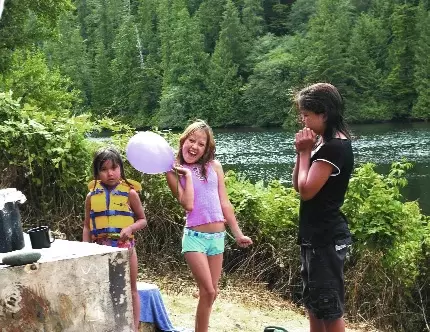A summer of tragedy has left the tight-knit communities of Esowista and Opitsaht yearning for healing relief and the leadership responded by offering their people a four day camping trip to one of their ancient village sites, Okemin.
Chief Councilor Moses Martin said eight of their people died within six weeks over the summer. The last death, a suicide, was almost too much for the people to bear.
“Our staff along with council took two days to debrief after the last funeral,” he explained. “It was suggested that we go back to the community campout, just to get together and have fun,” he said.
Friends from Chehalis, USA arrived to take part in a cleansing ceremony August 27 which was performed on the beautiful beach at Esowista.
Located deep within Tofino Inlet, Okemin shows signs that it was once a village. The tiny cabins are long gone but the old fruit trees, berry bushes and alder remain as reminders of a once thriving community.
A small work crew arrived a few weeks earlier to clear away brush so that the families would have plenty of room to set up tents for the more than 130 people who would take part in the campout.
Elder Larry Curley, perched on the bank facing the inlet, said he was happy to be there and goes every chance he can get. The place he chose to set up his tent was the site of his childhood home where he stayed with his grandparents. Now he takes his grandchildren there to watch them have fun.
He described the cleansing ceremony at Long Beach as a positive event. “We did it so our community would do better; lots went and if felt good, it was powerful,” he said.
The campout, he continued, was about leaving sorrows behind and making their kids happy.
Tom Curley called the campout icing on the cake after the cleansing ceremony at Long Beach. “It was a really good thing,” he continued, “we felt like we were getting over-loaded with emotional stress and we were losing focus.”
Besides swimming and arts & crafts for the kids there was also fishing. Kids would cast their lines right off the dock for trout coming from the nearby Kennedy River. Some would go on boat trips with the adults to fish for salmon or crab.
Meals and some camping equipment were provided by the band. People were invited to the small, wooden cookhouse for meals each day.
In the evenings families would gather around the fire and listen to the elders tell stories and legends. One night it was said that elder Tom Curley told stories of a great Tla-o-qui-aht chief and his mystical powers to a spell-bound audience.
When they’re not telling stories they’re playing lahal.
“It’s fun to watch the kids; they get up early in the morning and swim all day long,” said Curley.
While the inlet is salt water, the people only have to take a short boat trip to Kennedy River where they bathed in fresh water.
Tla-o-qui-aht’s community campouts started about five years earlier. Larry said there were so many people the first year that there was hardly any room to walk between the tents; and still, people didn’t want to leave when the time came.
Okemin, according to the Curley brothers is rich with history. Looking over the water, Tom said there were once houses lining both sides of the inlet. He believes the first settlers arrived there in the 1880’s, and were looking to buy land.
Situated near the mouth of Kennedy River, Okemin, also known as Cannery Bay, was teeming with salmon.
“We would be swimming until midnight and we could feel the salmon bumping against us,” Larry remembered. His grandmother would yell for the kids to come in but his grandfather would tell her to leave them alone, they’re having fun.
Tom remembers a time when sockeye salmon would spawn in Kennedy Lake. “All those nice gravel beaches along the edge of the highway, they would spawn there, but not anymore,” he said.
A cannery was built in the 1920’s and gradually, families began to move to the more easily accessible TFN communities of Opitsaht on Meares Island or Esowista on Long Beach.
Eventually the small wooden cabins collapsed and returned to the earth. But the site still carries its happy memories and continues to make more with a new generation of Tla-o-qui-aht members.
By Denise Titian







